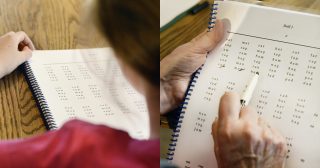Laterality and Directionality: How Does it Relate to Learning?
February 16th, 2022The Impact of Directionality and Learning
How many times have you seen a pre-schooler so proudly reading a book, upside down and backward? They do not understand how reading works. The bridge between laterality and directionality is still being developed. They have not learned how to read a page or even which side of the book is the front versus the back or the top versus the bottom.
The English language is based on a left to right and top to bottom orientation. This is the basis for both reading and writing.
Laterality and directionality are learned skills. Additionally, understanding directional terms like left, right, top, bottom, above, below, beside, under, over, between, through, and behind are essential to good reading, writing, and fundamental learning skills.
What is Laterality and Directionality?
Laterality is the internal awareness of space located to the right and left of the midline of your body. It is the internal awareness of both your right and left side of your body working together and in opposition to each other.
Your sense of laterality begins when you are a baby. For example, when you learn how to crawl, both sides of your body work together in tandem. Directionality takes this awareness of left and right a step further.
Directionality is your ability to take the concept of left and right into the space beyond your fingertips. Directionality is the ability to see right and left on other objects. With directionality, you are able to detect how words appear left to right on a page of text.
Visual perception and spatial awareness are tied directly to laterality and directionality.
Your ability to place numbers in columns, align words neatly on a page, proper spacing of words, and scan a page from left to right are all directly impacted by directionality.
During movement exercises or physical education, directionality difficulties show up in the child who can’t seem to stay in step with the rest of the class. Problems with balance and spatial awareness are directly related to one’s sense of laterality.
We read from top to bottom and left to right. We form letters in specific directions. Even writing your letters correctly involves directionality. Starting letters at the top and moving down is easier and faster and coincides with how we read. Yet, kids often start writing letters from the bottom up.
Again, directionality is the ability to project lateral awareness of the concept of left and right into the space outside our bodies. So, you are able to identify the placement of objects in an environment. For example, the whiteboard is on the right side of the classroom and the windows are on the left.
Writing letters facing the correct way is another example of directionality. An example of directional difficulties while following directions would be making a left turn when you were supposed to make a right turn. Another example would be writing your letters backward or reading words backward.
Directionality: Real-Life Examples
Directionality helps you find where you have parked your car in a parking lot. A number of years ago, a dear friend of mine, along with my husband and I were in Downtown Chicago. Both my friend and I grew up in Chicago.
We were looking for a particular building and I said we needed to go to the right as the building we were looking for was closer to Lake Michigan. My friend kept saying the building was to the left.
Finally, to avert an argument, we asked for assistance. Yes, we really wanted to turn right. The lake was to the right of us. Directionality impacts us each and every day in one way or another.
Your ability to follow Google or Apple maps is dependent on following directions, turning right or left when told to.
Directionality, Laterality, and Learning: The Impact
When directionality and laterality areas of processing are not working as well as they should be, reading is more difficult than it should be. Problems in these areas directly impact reading comprehension skills and your ability to read fluently.
Laterality and directionality also impact spatial awareness and your ability to mentally visualize both objects and stories (which helps memory skills) and rotate objects in space. Remember, a ‘d’ is the same shape as a ‘b’ and flipped down and over a ‘p’ or a ‘q’.
The US National Library of Medicine National Institutes of Health report states:
A meta-analysis of Uttal et al. (2013) proved stable and transferable improvement of visuo-spatial abilities via special forms of spatial training even if the post-tests were not conducted immediately after finishing the training period. Besides that, the increase of subjects with initially weaker visuo-spatial abilities was larger than for rather skilled subjects.
This report also notes, “There is a lot of research which shows the relation of motor tasks, particularly motor tasks, which are conducted with hands and different kinds of cognitive activity, especially the influence on mental rotation performance of children and adults.” (Wohlschläger and Wohlschläger, 1998; Wiedenbauer and Jansen-Osmann, 2008).
Activities to Improve Directionality and Laterality Skills
- For younger students with reading material, draw green go signs at the left of the page and red stop signs at the right of the page
- Do the Hokey Pokey
- Play Twister
- Have your kids write directions on how to get somewhere by looking at a map, without Google listing out the steps!
- Play sports like soccer or basketball where you are moving forward, backward, left, and right
- Fluency Training (improves directionality: left to right, letter orientation, and reading fluency skills)
More Directionality and Laterality Activities
Are you interested in more directionality and laterality activities? Take a look at our upcoming Summer Reading Program. It is loaded with brain-body activities that focus on improving directionality and laterality skills.
At-Home Online Summer Reading Program
Reading Fluency Training
The Reading Fluency Training Program offers practice in improving visual discrimination, form constancy, and many other areas of perception.
“When I first heard of Bonnie Terry’s Reading Fluency Training Program, I assumed it was only for beginning readers. Not so! It’s for everyone! My kids from 3rd to 6th grade are already benefiting from it and we’ve only been using it for a week. Their reading speed, confidence, and comprehension are going up by leaps and bounds!”
Who is Bonnie Terry?
Bonnie Terry is a Board Certified Educational Therapist and internationally recognized as America’s Leading Learning Specialist, the founder of BonnieTerryLearning.com, and the co-founder of Scholar Within. Terry is an expert in developing reading and spelling programs that target how people learn through the visual, auditory, and tactile/kinesthetic processing systems. Terry coaches teachers and parents so they can give their child a 2 to 4-year learning advantage in just 45-60 minutes a day. She is a frequent media guest and speaker.






























